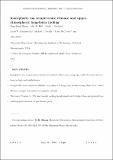| dc.contributor.author | Nicolls, Michael J. | |
| dc.contributor.author | McCready, Mary | |
| dc.contributor.author | Kelly, John | |
| dc.contributor.author | Zhang, Shun-Rong | |
| dc.contributor.author | Holt, John M | |
| dc.contributor.author | Erickson, Philip J | |
| dc.contributor.author | Goncharenko, Larisa | |
| dc.date.accessioned | 2017-03-21T20:07:50Z | |
| dc.date.available | 2017-03-21T20:07:50Z | |
| dc.date.issued | 2016-09 | |
| dc.date.submitted | 2016-07 | |
| dc.identifier.issn | 2169-9380 | |
| dc.identifier.issn | 2169-9402 | |
| dc.identifier.uri | http://hdl.handle.net/1721.1/107625 | |
| dc.description.abstract | It is now recognized that Earth's upper atmosphere is experiencing a long-term cooling over the past several solar cycles. The potential impact of the cooling on societal activities is significant, but a fundamental scientific question exists regarding the drivers of the cooling. New observations and analyses provide crucial advances in our knowledge of these important processes. We investigate ionospheric ion temperature climatology and long-term trends using up-to-date large and consistent ground-based data sets as measured by multiple incoherent scatter radars (ISRs). The very comprehensive view provided by these unique observations of the upper atmospheric thermal status allows us to address drivers of strong cooling previously observed by ISRs. We use observations from two high-latitude sites at Sondrestrom (invariant latitude 73.2°N) from 1990 to 2015 and Chatanika/Poker Flat (invariant latitude 65.9°N) over the span of 1976–2015 (with a gap from 1983 to 2006). Results are compared to conditions at the midlatitude Millstone Hill site (invariant latitude 52.8°N) from 1968 to 2015. The aggregate radar observations have very comparable and consistent altitude dependence of long-term trends. In particular, the lower F region (<275 km) exhibits dayside cooling trends that are significantly higher (−3 to −1 K/yr at 250 km) than anticipated from model predictions given the anthropogenic increase of greenhouse gases. Above 275 km, cooling trends continue to increase in magnitude but values are strongly dependent on magnetic latitude, suggesting the presence of significant downward influences from nonneutral atmospheric processes. | en_US |
| dc.description.sponsorship | National Science Foundation (U.S.) (Awards AGS-1042569 and AGS-1343056) | en_US |
| dc.language.iso | en_US | |
| dc.publisher | American Geophysical Union (AGU) | en_US |
| dc.relation.isversionof | http://doi.org/10.1002/2016JA022971 | en_US |
| dc.rights | Article is made available in accordance with the publisher's policy and may be subject to US copyright law. Please refer to the publisher's site for terms of use. | en_US |
| dc.source | Zhang | en_US |
| dc.title | Ionospheric ion temperature climate and upper atmospheric long-term cooling | en_US |
| dc.type | Article | en_US |
| dc.identifier.citation | Zhang, Shun-Rong et al. “Ionospheric Ion Temperature Climate and Upper Atmospheric Long-Term Cooling: UPPER ATMOSPHERIC COOLING.” Journal of Geophysical Research: Space Physics 121.9 (2016): 8951–8968. | en_US |
| dc.contributor.department | Haystack Observatory | en_US |
| dc.contributor.approver | Zhang, Shun-Rong | en_US |
| dc.contributor.mitauthor | Zhang, Shun-Rong | |
| dc.contributor.mitauthor | Holt, John M | |
| dc.contributor.mitauthor | Erickson, Philip J | |
| dc.contributor.mitauthor | Goncharenko, Larisa | |
| dc.relation.journal | Journal of Geophysical Research: Space Physics | en_US |
| dc.eprint.version | Author's final manuscript | en_US |
| dc.type.uri | http://purl.org/eprint/type/JournalArticle | en_US |
| eprint.status | http://purl.org/eprint/status/PeerReviewed | en_US |
| dspace.orderedauthors | Zhang, Shun-Rong; Holt, John M.; Erickson, Philip J.; Goncharenko, Larisa P.; Nicolls, Michael J.; McCready, Mary; Kelly, John | en_US |
| dspace.embargo.terms | N | en_US |
| mit.license | PUBLISHER_POLICY | en_US |
